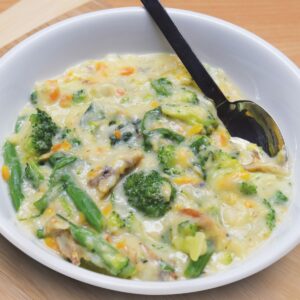
Pineapple
This delicious, sweet, versatile fruit is often associated with summer, but is available all year round because it’s largely imported. Pineapples can be homegrown from the crown of a supermarket fruit, but take up to three years to come to full maturity. Originally indigenous to South America, pineapples made their way to Hawaii. Although most pineapples are now grown in South America and the Philippines, pineapple on pizzas still gets called ‘Hawaiian’.
The pineapple is a herbaceous perennial and usually grows to 1m to 1.5m tall. Each plant can fruit three times during its lifetime.
Similar to pine cones (and, in fact, named after them by European explorers), pineapple plants create the fruit/cone by fusing up to 200 flowers together.
A 1.5cm slice of pineapple contains just 250kJ and provides 2.3g fibre and a range of vitamins and minerals. Pineapples contain bromelain, a compound that has been used for its anti-inflammatory and analgesic properties as a treatment for osteoarthitis.
Recipes
Chilli
Chilli peppers are yet another plant native to South and Central America and were domesticated more than 6000 years ago in Mexico. Chillies are the fruit of capsicum plants but the hotter, spicier varieties. Spicy heat is measured in Scoville heat units (SHU), which looks at the concentration of capsaicinoids (an active irritant) in the pepper.
When explorer Christopher Columbus discovered America in 1493, thinking it was India, he also mistakenly thought chillies were the plant that produced black pepper – hence the name chilli ‘pepper’. Their spread around the world came after Columbus took the plants back to Spain.
Now, with over 400 different varieties of chillies globally, they’re eaten fresh, dried or ground into powder and are a hugely popular flavour ingredient.
India is the world’s largest producer and exporter of chilli with 25 per cent of total global production.
Capsaicin, the compound in chilli that delivers the heat, has been associated with a range of possible health benefits.
A 2017 US study found higher consumption of hot red chilli pepper was associated with reduced mortality, supporting findings of a 2015 Chinese study. Possible explanations for the health benefits are that capsaicin is thought to play a role in cellular mechanisms that prevent obesity and modulate blood flow around the heart. Capsaicin also has antimicrobial properties that could alter gut microbiota.
Recipes
Fresh this month
(Harvested in New Zealand gardens in March)
Vegetables
Beetroot, broccoli, cabbage (green), capsicum, carrot, cauliflower, celery, chilli pepper, courgette, cucumber, eggplant, fennel, kumara, leek, lettuce, onion, parsnip, potato, pumpkin, radish, runner bean, shallot, spinach, spring onion, squash, swede, sweet corn, tomato, turnip.
Herbs
Basil, chives, coriander, dill, marjoram, mint, oregano, parsley, rosemary, sage, thyme.
Fruit
Avocado, apple, grape, kiwifruit, lemon, lime, orange, passion fruit, pear, pineapple.
www.healthyfood.com










